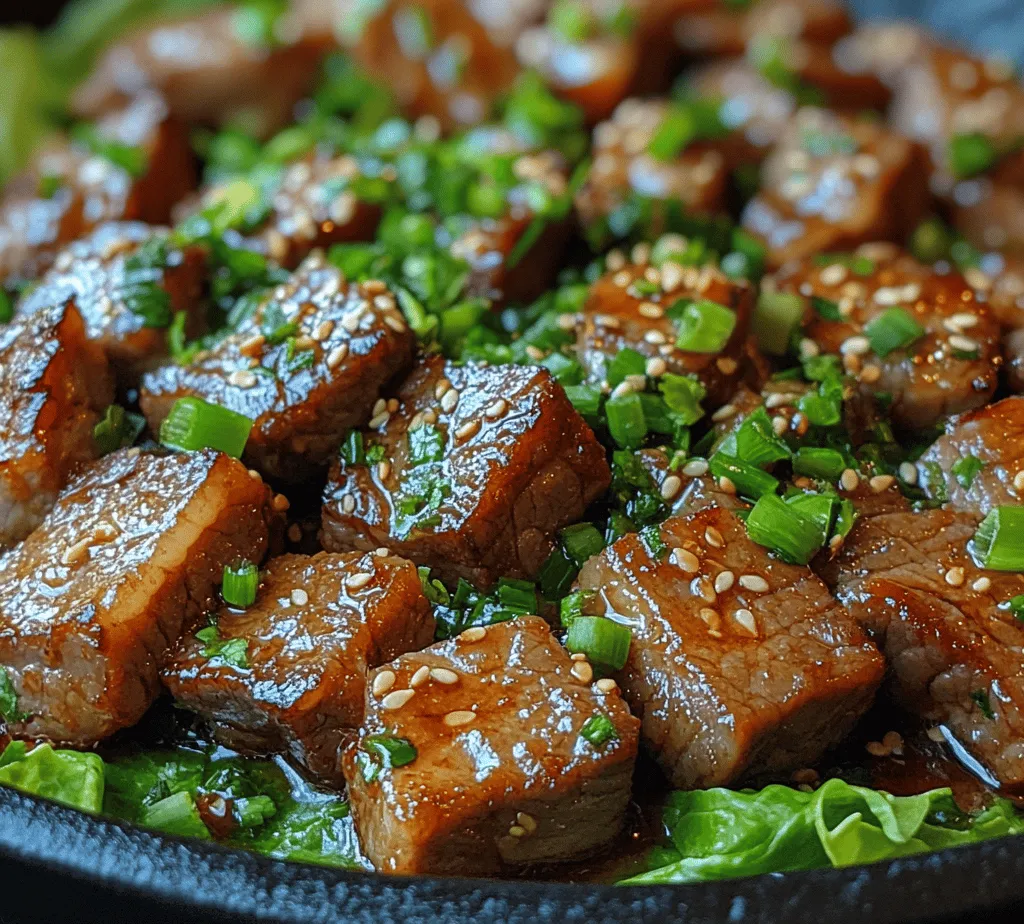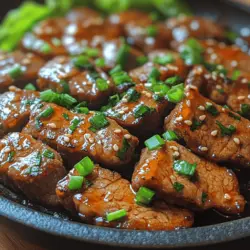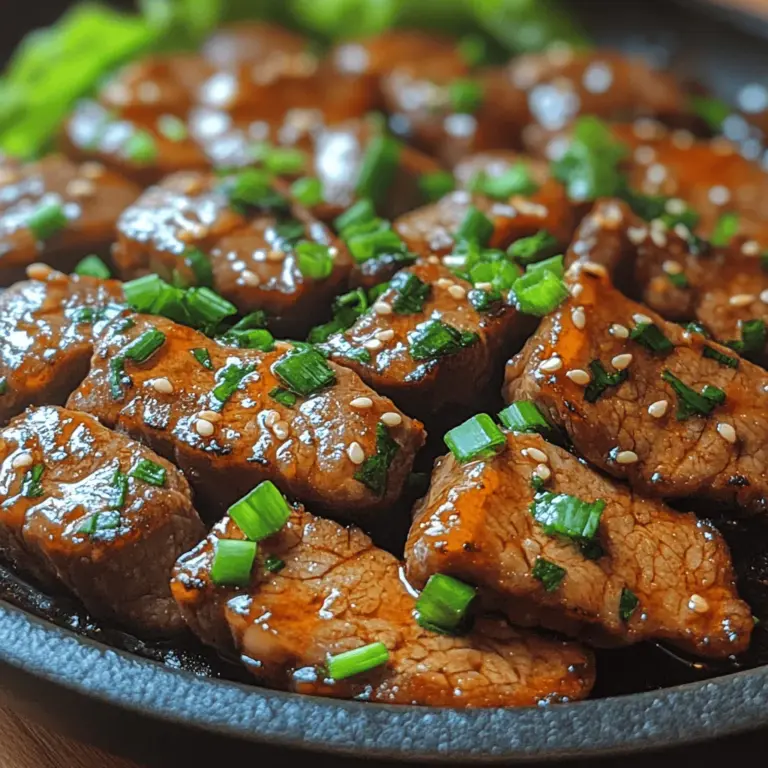Introduction
Korean cuisine has carved a distinctive niche on the global culinary stage, celebrated for its bold flavors, vibrant colors, and rich cultural history. From the iconic kimchi to sizzling barbecue dishes, Korean food captures the essence of communal dining and the joy of sharing. Among the myriad of dishes that represent this culinary heritage, Bulgogi stands out as a true favorite. This traditional dish, which translates to “fire meat,” encapsulates the heart and soul of Korean cooking, marrying savory, sweet, and spicy elements in a harmonious blend that excites the palate.
Spicy Korean Beef Bulgogi, in particular, has gained immense popularity not only in Korea but also in various parts of the world. Its versatility allows it to be enjoyed in different forms, whether served over a bowl of steaming rice, tucked into lettuce wraps, or accompanied by a medley of side dishes, known as banchan. This dish is not just a meal; it is an experience, inviting diners to savor the flavors while appreciating the cultural significance behind each ingredient and cooking technique.
In this article, we aim to provide a comprehensive recipe for Spicy Korean Beef Bulgogi, along with insights into its origins, variations, and the role it plays in Korean gatherings and celebrations. Whether you are a seasoned home cook or a newcomer to Korean cuisine, this guide will help you navigate the process of creating this delicious dish, ensuring that you can bring a taste of Korea into your kitchen.
Understanding Bulgogi
Bulgogi is a quintessential Korean dish that has a rich history dating back to the Goguryeo era (37 B.C. – 668 A.D.). Originally, it was made with marinated beef that was grilled over an open flame, showcasing the traditional Korean barbecue method. The name “Bulgogi” derives from the Korean words “bul,” meaning fire, and “gogi,” meaning meat, aptly describing the cooking technique used to prepare this dish.
Over the centuries, Bulgogi has evolved into various regional adaptations across Korea, each with its unique twist on flavor and preparation. For instance, in Jeolla Province, you might find a sweeter version with more sugar and fruit juices, while in Gyeongsang Province, the emphasis may lean more toward umami-rich soy-based marinades. Regardless of the variation, the common thread remains: Bulgogi is celebrated for its tender, flavorful meat that captivates diners’ hearts.
Culturally, Bulgogi plays a significant role in Korean gatherings and celebrations. It is often served during family get-togethers, birthdays, and special occasions, making it more than just a meal—it’s a symbol of love, togetherness, and hospitality. Bulgogi is also a staple in Korean barbecues, where it is grilled right at the table, enhancing the dining experience with an interactive and communal feel.
Ingredients Breakdown
To prepare Spicy Korean Beef Bulgogi, selecting the right ingredients is crucial to achieving the authentic taste and texture that defines this dish. Let’s break down the key components that come together to create this culinary delight.
Beef Sirloin
The foundation of any great Bulgogi is the beef itself. For our Spicy Korean Beef Bulgogi, beef sirloin is the preferred cut due to its tenderness and flavor. When choosing beef for Bulgogi, look for well-marbled sirloin, as the fat content enhances the meat’s juiciness and richness during cooking. Slicing the beef thinly against the grain is essential; this ensures that each bite is tender and easy to chew, contributing to the overall enjoyment of the dish.
Soy Sauce
Soy sauce is a cornerstone of Asian cooking, providing depth of flavor and umami richness. In Bulgogi, it serves as the primary seasoning agent, imparting a savory note that complements the natural sweetness of the beef. Opt for a high-quality soy sauce, as it will significantly influence the taste. The amount of soy sauce used in the marinade can be adjusted based on your preference for saltiness, but it is essential to include it for that authentic flavor.
Gochujang
Gochujang, a staple Korean condiment, is a fermented red chili paste that adds a distinctive heat and complexity to the dish. Made from red chili powder, glutinous rice, fermented soybeans, and salt, gochujang is known for its rich flavor profile, which combines sweetness, spiciness, and depth. In Spicy Korean Beef Bulgogi, it provides the signature kick that sets this dish apart. Adjust the quantity to match your spice tolerance, as gochujang can range from mildly spicy to fiery depending on the brand.
Brown Sugar or Honey
A touch of sweetness is essential in balancing the savory and spicy elements of Bulgogi. Brown sugar or honey is commonly added to the marinade to enhance the flavor profile. Brown sugar, with its molasses content, contributes a deeper, more complex sweetness, while honey offers a lighter, floral note. Both options work well, so feel free to use whichever you prefer or have on hand.
Sesame Oil
Sesame oil is another vital ingredient that elevates the overall flavor of Spicy Korean Beef Bulgogi. This oil is pressed from toasted sesame seeds, imparting a nutty richness to the dish. A drizzle of sesame oil in the marinade adds depth and enhances the aroma, making the dish even more enticing. It’s essential not to overdo it, as a little goes a long way in providing that signature taste.
Garlic and Ginger
Aromatic ingredients like garlic and ginger are crucial in creating a well-rounded flavor in Bulgogi. Fresh garlic offers a pungent, zesty note, while ginger adds warmth and a hint of spiciness. Together, they enhance the overall taste of the marinade, ensuring that every bite is infused with their delightful essence. For the best results, use fresh garlic and ginger, finely minced or grated, to maximize their flavors.
Rice Wine
Rice wine, such as mirin or soju, is sometimes included in Bulgogi marinades to provide acidity and brightness to the dish. This ingredient helps tenderize the meat while adding a subtle tang that balances the flavors. If you don’t have rice wine on hand, you can substitute it with a splash of white wine or even apple cider vinegar, though the taste may vary slightly.
Black Pepper
While not traditionally emphasized in Bulgogi recipes, a dash of black pepper can enhance the dish by adding a gentle heat and depth to the marinade. It complements the other ingredients without overpowering them, providing a subtle kick that rounds out the flavor profile.
Onion and Green Onions
Onions contribute both flavor and texture to Spicy Korean Beef Bulgogi. Thinly sliced onions are often marinated with the beef, softening and caramelizing during the cooking process, while adding a sweet and savory component. Green onions are typically used as a garnish, providing a fresh, vibrant touch that contrasts beautifully with the rich flavors of the meat.
Sesame Seeds
For garnish, toasted sesame seeds are sprinkled over the finished dish, adding both visual appeal and a delightful crunch. They also enhance the nutty flavor profile, tying together the elements of the dish. When serving, don’t skip this simple yet impactful step, as it adds the finishing touch to your Bulgogi.
Lettuce Leaves
In Korean cuisine, wrapping dishes in lettuce leaves is a beloved tradition, and Bulgogi is no exception. Crisp lettuce leaves, such as romaine or butter lettuce, serve as the perfect vessel for holding the flavorful beef and other accompaniments. The fresh, crunchy texture of the lettuce complements the tender meat, creating a delightful contrast that enhances the overall eating experience.
Preparation Steps
Now that we have explored the essential ingredients for Spicy Korean Beef Bulgogi, let’s dive into the preparation steps that will guide you through the cooking process. Follow these clear, detailed instructions to achieve the perfect Bulgogi at home.
1. Prepare the Beef: Begin by selecting a high-quality beef sirloin. Trim any excess fat, if needed, and slice the meat thinly against the grain. Aim for slices about 1/8 to 1/4 inch thick for optimal tenderness. Place the sliced beef in a large mixing bowl.
2. Make the Marinade: In a separate bowl, combine the soy sauce, gochujang, brown sugar (or honey), sesame oil, minced garlic, minced ginger, and rice wine. Whisk the ingredients together until the sugar is dissolved and the mixture is well blended. Taste the marinade and adjust the seasoning, adding more soy sauce for saltiness or gochujang for heat, depending on your preference.
3. Marinate the Beef: Pour the marinade over the sliced beef, ensuring that each piece is thoroughly coated. Cover the bowl with plastic wrap or transfer the mixture to a resealable plastic bag, removing as much air as possible. Allow the beef to marinate for at least 30 minutes at room temperature or, for best results, refrigerate for up to 4 hours (or overnight) to deepen the flavors.
4. Prepare the Vegetables: While the beef marinates, prepare the onions and green onions. Thinly slice the onions and chop the green onions, setting them aside for later use.
5. Cook the Beef: Heat a large skillet or grill pan over medium-high heat. Once the pan is hot, add the marinated beef in a single layer, being careful not to overcrowd the pan. Cook for about 2-3 minutes per side, or until the beef is browned and cooked through. In the final minute of cooking, add the sliced onions to the pan, stirring them in to soften and caramelize slightly.
6. Garnish and Serve: Once cooked, transfer the Bulgogi to a serving platter. Sprinkle with toasted sesame seeds and the chopped green onions for garnish. Serve the Spicy Korean Beef Bulgogi with fresh lettuce leaves for wrapping, along with steamed rice or your favorite side dishes.
By following these preparation steps, you will create a delectable Spicy Korean Beef Bulgogi that is sure to impress your family and friends. This dish not only showcases the rich flavors of Korean cuisine but also offers a glimpse into the cultural significance of sharing meals together. Stay tuned for the next part of this article, where we will delve into serving suggestions, tips for best results, and answers to common questions about this beloved dish.


